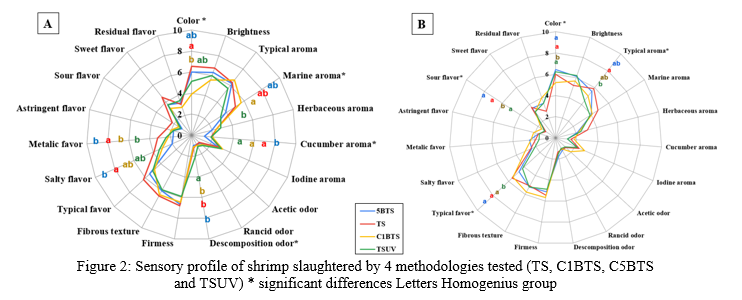KEEPING IT FRESH: HOW SLAUGHTER METHODS IMPACT QUALITY AND SHELF LIFE OF BIOFLOC-CULTURED SHRIMP
Introduction
Shrimp are a highly perishable product due to their rapid microbiological and biochemical spoilage post-harvest. The biofloc system contains a rich microbial community that benefits Penaeus vannamei production, modulates its associated gut microbiota, and enhances the immune system, potentially influencing post-mortem freshness. Ensuring high product quality is essential for market acceptance, and the initial microbial load plays a key role in shelf life. This study evaluates the impact of different slaughter methods on the freshness and refrigerated stability of shrimp reared under biofloc conditions, highlighting the interaction between microbiota, slaughter technique, and quality parameters as a basis for optimizing post-harvest practices in intensive aquaculture.
Material and Methods
Shrimp were cultured at 350 kg/m³ in 3 m³ indoor biofloc tanks and fed commercial feed (LeGoussant) until reaching average weight of 15 g . Water quality parameters were maintained within optimal ranges for white shrimp (Van Wyk, 1999). Four slaughter methods were evaluated: cold thermal shock using r efrigerated seawater (-2ºC) (TS, control) (TS was implemented in all slaughter methods) ; 5 min immersion in refrigerated seawater (0±2. 5 ºC) with 50 ppm bleach followed by TS (5BTS); clarification (3–4 h) before 50 ppm bleach and TS (C1BTS); and TS followed by 2 min UV exposure in each side of the shrimp (TSUV). After slaughter, shrimp were packed in sealed plastic bags and cold storage icing was performed over time at 0±2 ºC between ice blocks. A shelf-life study was conducted at 0- , 3-, 6-, 9-, and 12-days post-mortem; microbiological count , physico chemical parameters (TVB-N) and Quantitative Descriptive Analysis (QDA) analyses were performed according to the standard ISO 13299 (Sensory profile).
Results and discussion
Microbiological analysis during cold storage of shrimp revealed significant temporal changes across all bacterial groups. Mesophilic bacteria remained most stable in the C1BTS treatment (~5.2 log CFU/g), likely due to gut-emptying prior to slaughter, while other treatments (TS, 5BTS, TSUV) began with higher counts and declined over time. Enterobacteria increased by ~3 log CFU/g by day 9 before returning to baseline, aligning with previous studies. Pseudomonas spp. declined until day 9, particularly in TS, then slightly rose by day 12, consistent with cold-shock recovery patterns. Spoilage-specific organisms decreased steadily, with initial higher counts in TS and TSUV. Psychrotrophic bacteria increased most markedly in TS, 5BTS, and TSUV (>2 log CFU/g), peaking at ~5.3 log CFU/g, while remaining lowest (~3.5 log CFU/g) in C1BTS. C1BTS consistently demonstrated superior microbial control. Total Volatile Basic Nitrogen (TVB-N) levels, an indicator of spoilage, increased across treatments but remained significantly lower in C1BTS. A strong correlation (r = 0.987) between psychrotrophic bacteria and TVB-N suggests that C1BTS reduced microbial growth and enzymatic degradation, thus improving shelf-life.
QDA analysis was used to assess the sensory quality of shrimp at 1- and 7-day post-mortem. Evaluations were conducted in the tasting room of the Pilot Plant, compliant with ISO 8589:2007.
Shrimp were served whole, boiled, and at room temperature to pre-trained evaluators. The sensory descriptors were established prior to the sessions. Over time, significant freshness-related descriptors such as marine and cucumber aroma, metallic and salty flavor (day 1) disappeared in all treatments, and were replaced by descriptors like typical aroma, typical flavor, and sour flavor (day 7) . By treatment, TS stood out for their color, cucumber aroma, and metallic and salty flavors on day 1 . And maintained superior scores in typical aroma and flavor and had the lowest sourness by day 7 . C1BTS shrimp showed strong marine aroma at day 1 but poor color, which persisted through day 7. Additionally, these samples exhibited the highest sourness on day 7. The 5 BTS shrimp with consistently intermediate profiles across all descriptors . TSUV group performed worst overall. They scored lowest in marine and typical aromas and highest in spoilage odor (day 1) and sourness (day 7), suggesting accelerated sensory degradation.
Overall, the C1BTS treatment proved to be the most effective in preserving shrimp quality during refrigerated storage, as evidenced by lower microbial loads, reduced spoilage indicators, and stable organoleptic attributes throughout the study. These findings underscore the potential of C1BTS as a promising approach to extend the shelf life of fresh shrimp under cold chain conditions
Acknowledgments
This work was supported by I+D+i Research Project: “Pursuing the zero waste in Biofloc Technology to produce a sustainable and biosafe aquaculture product (ZeroFloc)” (PID2023-149570OB-I00). S.Ferrando-Juan has a predoctoral Research Personnel Training Grant (PRE2021-098367); supported by MCIN/ AEI/10.13039/501100011033/. J. Gómez-Aguilera contract was supported by European Union Next Generation-Plan of Conselleria d’innovació, Universitats, Ciència i Societat Digital of Generalitat Valenciana (INVEST/2022/434).
Bibliography
ISO 16779. (2015). Sensory analysis — Assessment (determination and verification) of the shelf life of foodstuffs.
Sahna Don; Martin, K.A.; Sukham, Binaya, y Nagalakshmi. (2018) “Identification of potential spoilage bacteria in farmed shrimp (Litopenaeus vannamei): Application of relative rate of spoilage models in shelf life-prediction”. LWT: Food Science and Technology 97 (8): 295-301.
Yang, S. P., Xie, J., & Qian, Y. F. (2017). Determination of spoilage microbiota of Pacific white shrimp during ambient and cold storage using next‐generation sequencing and culture‐dependent method. Journal of Food Science, 82(5), 1178-1183.
